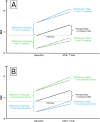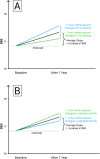The Association Between Longitudinal Changes in Body Mass Index and Longitudinal Changes in Hours of Screen Time, and Hours of Physical Activity in German Children
- PMID: 39720157
- PMCID: PMC11667765
- DOI: 10.1002/osp4.70031
The Association Between Longitudinal Changes in Body Mass Index and Longitudinal Changes in Hours of Screen Time, and Hours of Physical Activity in German Children
Abstract
Introduction: The association of screen time and physical activity with body weight in children has been investigated in cross-sectional and prospective studies, as well as randomized controlled trials. The present study extends previous research by examining how longitudinal within-person changes in screen time and physical activity relate to changes in Body Mass Index (BMI) in children, and how changes in screen time and physical activity relate to each other.
Methods: The data for the present study came from the PIER Youth Study. Data were collected from 971 children and their parents at two time points approximately 1 year apart. A multilevel modeling approach with measurement occasions nested within children was used to model changes in BMI across age.
Results: Within a child, a change in daily hours of TV viewing was associated with a corresponding change in BMI, whereas a change in daily hours of physical activity was associated with an opposite change in BMI. Within-person correlations between changes in screen time and physical activity were small but positive.
Conclusion: The present findings have important implications for interventions to reduce and prevent childhood overweight and obesity. Specifically, interventions should focus on both reducing daily TV viewing and promoting physical activity.
Keywords: body weight; childhood; leisure activities; obesity; overweight; television viewing.
© 2024 The Author(s). Obesity Science & Practice published by World Obesity and The Obesity Society and John Wiley & Sons Ltd.
Conflict of interest statement
The authors declare no conflicts of interest.
Figures


Similar articles
-
The effectiveness of web-based programs on the reduction of childhood obesity in school-aged children: A systematic review.JBI Libr Syst Rev. 2012;10(42 Suppl):1-14. doi: 10.11124/jbisrir-2012-248. JBI Libr Syst Rev. 2012. PMID: 27820152
-
The neighborhood social environment and body mass index among youth: a mediation analysis.Int J Behav Nutr Phys Act. 2012 Mar 20;9:31. doi: 10.1186/1479-5868-9-31. Int J Behav Nutr Phys Act. 2012. PMID: 22429957 Free PMC article.
-
Lack of association between television viewing, soft drinks, physical activity and body mass index in children.Acta Paediatr. 2008 Jun;97(6):795-800. doi: 10.1111/j.1651-2227.2008.00713.x. Epub 2008 Apr 9. Acta Paediatr. 2008. PMID: 18410467
-
Association between TV viewing, computer use and overweight, determinants and competing activities of screen time in 4- to 13-year-old children.Int J Obes (Lond). 2013 Jan;37(1):47-53. doi: 10.1038/ijo.2011.244. Epub 2011 Dec 13. Int J Obes (Lond). 2013. PMID: 22158265
-
Television viewing and television in bedroom associated with overweight risk among low-income preschool children.Pediatrics. 2002 Jun;109(6):1028-35. doi: 10.1542/peds.109.6.1028. Pediatrics. 2002. PMID: 12042539
Cited by
-
The Impact of Parental Behaviors on Children's Lifestyle, Dietary Habits, Screen Time, Sleep Patterns, Mental Health, and BMI: A Scoping Review.Children (Basel). 2025 Feb 8;12(2):203. doi: 10.3390/children12020203. Children (Basel). 2025. PMID: 40003305 Free PMC article. Review.
References
-
- Word Health Organization , Obesity and Overweight, updated March 24, 2024, accessed May 6, 2024, https://www.who.int/news‐room/fact‐sheets/detail/obesity‐and‐overweight.
-
- Word Health Organization , WHO European Regional Obesity Report 2022 (2022), https://www.who.int/europe/publications/i/item/9789289057738.
LinkOut - more resources
Full Text Sources
